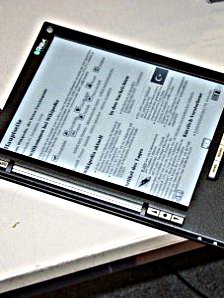from wittenberg to e-paper
Among others the city of Wittenberg (images from my last bike trip) is famous because Martin Luther nailed his 95 theses against the selling of indulgences at the door of the Castle Church in Wittenberg (image above), marking the beginning of the Protestant Reformation in Germany (modern analogies of indulgences are e.g. the current too cheap CO2 greenhouse gas vouchers of airplane companies). His original intention was to reform the catholic church, but as a matter of fact the catholic church wasn’t up for reforms and thus protests ran a bit out of control. As a result Luther had to flee and hide in the castle of Eisenach (where he translated the bible into german).
Nowadays the castle of the Castle Church hosts a hostel, with its typical GDR chic:
…but soon this hostel will turn into a museum.
Wittenberg hosts also the house of Lucas Cranach the Elder whose Woodcut printing workshop printed a lot of Luthers works and thus finally helped to make his ideas accessible to a greater public:
Interestingly – despite the ban of worldly images in protestant churches Lucas Cranach himself and also other artists (above a woodcut about the customs of the curiae by Hans Baldung) made expressive illustrations to the texts. These illustrations were (in expensive editions) even hand coloured:
The importance of images versus texts and their combination is still an ongoing sujet of debate, as can be e.g. seen at the discussion about the decision of the FAZ to put images on their front side. Nowadays most print media seem to have images on their front side. And clearly the development of printing techniques made these images look very differently than at Cranachs time:
Given the current polychrome capabilities of e paper I wonder how these new techniques will influence the way images and texts are treated and perceived. So I think it is noteworthy that this month saw the first e-paper edition of a newspaper, namely the newspaper les echos.

Last but not least by looking at a fridge and thinking about why it seems to be difficult to join the two concepts of e paper and digital paper (here a list of applications based on interactive paper by the Global Informations Systems Group with e.g. this easy readable, super instructive city Guide) I had the idea for a magnetic interactive-W-Lan-e-paper-fridge-calendar (and i definitely won’t claim a patent for this too obvious “innovation”…).
August 1st, 2014 at 11:09 pm
Regarding the above print one can only say: at least M. Luther didn’t abduct the pope.
May 30th, 2017 at 4:57 pm
By the way Luther was not only anti-pope but also anti-semite:
https://en.wikipedia.org/wiki/Martin_Luther_and_antisemitism
I think you should have mentioned this.
May 30th, 2017 at 5:45 pm
@A Luther critic
You have to see this in an historical context. Certainly there are texts by Luther which appear by nowadays understanding unacceptable, but they are immersed into a fundamentally different cultural setting and any interpretation has to take these very different circumstances into account.
I invite you to engage into a dialogue with proponents of modern Lutherism.
For example the International Martin Luther Foundation organizes conferences that promote debates.
From the preamble of the foundation’s constitution:
<a href="http://www.luther-stiftung.org/index.php?id=13&L=1
July 31st, 2018 at 8:03 am
Political or church leaders are always subject to critics – even within the lutheran church, as can for example be seen at what Jutta Dithfurt thought about the former president of Germany pastor Joachim Gauck.
August 1st, 2018 at 8:15 am
@controversial
What did this Jutta Dithfurt think about president Gauck? Did she say something about Mr. Gauck and the Stasi? Frankly I don’t understand the Stasi remarks in the link you provided. Wikipedia says about Gauck that he was a GDR regime opponent:
and